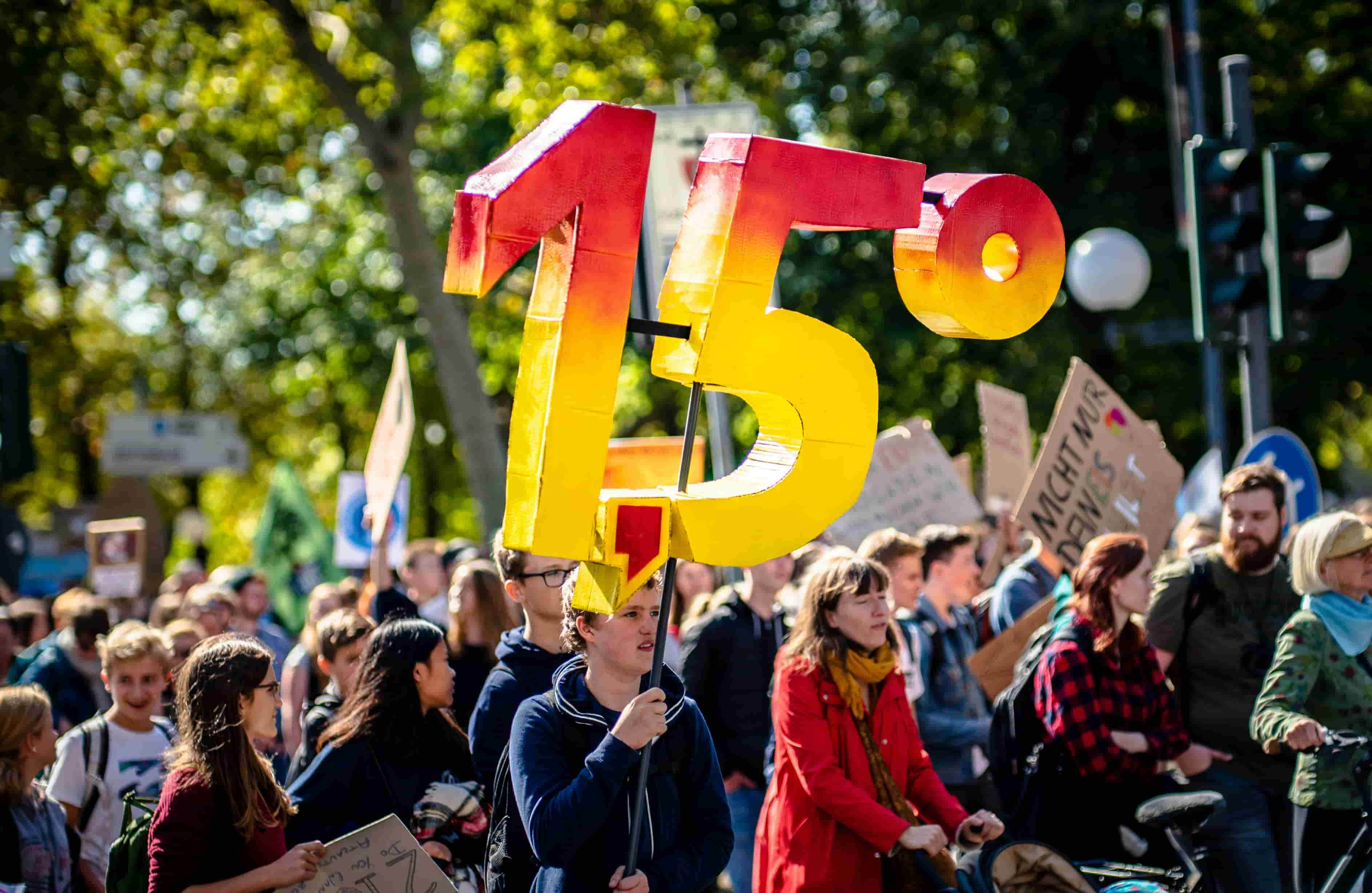While climate change is a complex problem in need of a unified global response, every individual effort towards building a safer future is valuable. By making changes to our individual lifestyles based on environmental concern, we can help to influence the attitudes and behaviours of those around us in relation to addressing the climate crisis. We can lead by example and assist in sending a message to those in positions of power that we will not stand for ‘business as usual.’ If you’re hesitant to take direct action in the form of joining a climate change protest or organisation, you can help to make a difference by trying to reduce your own carbon footprint.

What is a carbon footprint?
You’ve probably noticed that the term “carbon footprint” is used a lot when discussing climate change. But what exactly does it mean? A carbon footprint is a way to measure greenhouse gas emissions. Greenhouse gases are gases such as carbon dioxide and methane that trap heat in the atmosphere and thereby contribute greatly to global warming. A carbon footprint is determined by the sum of these greenhouse gases that are released into the atmosphere either directly or indirectly by our actions (usually in tons per year). This can be applied to individuals, families, companies, events, products and even countries.
How is my carbon footprint measured?
Your carbon footprint is measured by your lifestyle and regular activities that result in greenhouse gas emissions. Some of the most common examples of these lifestyle factors and activities include:
- Transport use
- Electricity use
- Dietary choices
- Purchasing habits
- General waste
So how can you measure yours?
The process of working out your own carbon footprint has never been easier. You can simply access any of the free carbon footprint calculators available online. One of the simplest and quickest can be found at www.conversation.org.
Why is it important to know your carbon footprint?
The higher your carbon footprint, the greater your contribution will be towards global warming and subsequently climate change.
While direct action must be taken against the biggest global carbon emitters, we would also do well to consider our own contributions.
By taking individual action to lower our own carbon emissions, we can help to reduce overall consumer demand in these industries. Many individuals making small changes to their daily lives can send a powerful message that we do not stand for ‘business as usual’ and demand a change in current practices.
How can I reduce my carbon footprint?
We are currently in a critical stage of human history where we have the opportunity to change the fate of our planet and secure a better world for future generations to come. One of the most immediate actions you can take to limit climate change is to reduce your own greenhouse gas emissions by lowering your carbon footprint.
Here are 10 simple ways that you can reduce your carbon footprint:
1. Move Your Money To Make A Difference

Source: Nattanan Kanchanaprat from Pixabay
Did you know that the way you choose to spend, save and invest your money can make a huge difference when it comes to reducing your carbon footprint? It’s no secret that some of the world’s largest banks love to use your hard-earned money to fund the fossil fuel industry. In fact, since the 2015 Paris Agreement the world’s 60 biggest banks have spent $3.8 trillion on fossil fuels! If you don’t fancy your money being used for environmental destruction and want to greatly reduce your individual carbon footprint, it’s time to make a change.
How can I do this?
- Investigate Your Institution. Is your money being used for good or evil? It’s time to find out. Head over to bank.green and enter your bank’s name to discover how sustainable your current financial institution is. Don’t like what you discover? Then perhaps it’s time to...
- Break Up With Your Bank. Say “It’s not me, it’s you” and leave your bank behind if you find out that they’re fraternising with the enemy. There’s no need to fear a fallout with your bank when you can use the handy tips and free email template available right here.
Go Green. So who can you trust with your money? Luckily, bank.green has made the process of choosing a sustainable bank super easy. You can compare the ethical banks available in your country and make the move today.
2. Eat more plant foods and less animal foods

Eating more plant foods can help to reduce your carbon footprint. Photo by Anna Pelzer on Unsplash
One of the greatest ways to reduce your carbon footprint begins with what you put on your plate every day. This is because the meat and dairy industries are some of the top contributors to global greenhouse gas emissions. In fact, some researchers have even suggested that these industries may be the leading cause of climate change.
So why are farm animals so toxic to the environment? Raising livestock for food produces large amounts of methane - a gas that traps much more heat than carbon dioxide. This makes it particularly dangerous when it comes to global warming. In addition to its impact on the climate, animal agriculture is also the leading cause of deforestation. As demand for animal products continues to increase, more land is cleared for livestock. This contributes greatly to global warming as cutting down trees not only releases stored carbon dioxide into the air but also reduces the Earth’s ability to naturally absorb greenhouse gases from the atmosphere.
While eating a plant-based diet may reduce your contribution to greenhouse gas emissions by as much as 73 percent, it’s important to note that the industrial production of fertilizer to produce plant foods is also problematic when it comes to greenhouse gas emissions. This is where regenerative agriculture (a holistic farming approach that focuses on soil health) could be a key solution.
In the meantime, getting more fruits and vegetables into your daily diet is a great way to both reduce your carbon footprint from current farming methods and improve your health.
How can I do this?
- If you’re not willing to give up meat straight away, a good way to begin is to try meat-free Mondays. By simply giving up meat for one day of the week, you will reduce your carbon footprint by as much as 8lbs (3.6kgs) per day, which is equivalent to not driving for two days. You can also try substituting your favourite meat products with popular plant-based alternatives such as Beyond Meat and Impossible Foods.
- Aim to eat things that are as low as possible on the food chain. This means eating mostly fruits, vegetables, legumes, beans, nuts, and seeds. This also has the added benefit of improving your health.
- Try replacing one meal a day with a plant-based option. For example, you might choose to have oatmeal for breakfast instead of bacon and eggs. Doing this may help to reduce your water and carbon footprint by about 25%.
3. Try other modes of transport

Riding your bike to work can reduce your environmental impact. Photo by Snapwire on pexels.com.
An average car produces approximately 4.6 metric tons of carbon dioxide per year. It does this by burning fossil fuels such as petrol, which then produces carbon dioxide from the exhaust pipe. As of 2018, road transport was responsible for at least 17% of global greenhouse gas emissions, according to one study. If you’re looking to reduce your carbon footprint, considering alternative modes of transport that don’t rely on the burning of fossil fuels will help you to do so.
How can I do this?
- If you live fairly close to your workplace, then riding your bike to work is one of the best ways to reduce your carbon footprint - with the added bonus of improving your health.
- Choose public transport where possible and avoid regular solo car trips.
- Take advantage of ride-sharing services.
- Work from home if you are able to do so.
- If using your car less is not an option, consider switching to an electric or hybrid vehicle.
4. Switch to a low-carbon energy provider

Solar power is a form of low-carbon energy. Photo by Sungrow EMEA on Unsplash.
Another great way to reduce your carbon footprint is to switch your electricity provider to a company that uses low-carbon energy. For example, renewable (or clean) energy comes from natural sources such as sunlight, wind or water. This has a much lower carbon footprint than energy that relies on the burning of fossil fuels.
Electricity and heat contributed as much as 15 billion tons (or 13.6 metric tons) of greenhouse gas emissions worldwide in 2016. That number continues to rise as changes in the climate lead to increased reliance on heating systems and air conditioning.
In order to avoid the catastrophic consequences of failing to take action against climate change, it is critical that we begin to reduce our reliance on the fossil fuel industry and move to low-carbon energy providers instead.
How can I do this?
- Identify whether your current electricity provider has any renewable energy options.
- If it is possible to do so, look into low-carbon energy providers in your local area. Ask questions of your new provider to ensure that their service is appropriate for your needs.
- If renewable energy is not an option, advocate for it to be introduced into the community by writing to your local government representative or your power company. The process of advocacy may differ depending on where you live.
5. Reduce, reuse, and recycle to waste less

Reduce, reuse, and recycle items in order to produce less waste. Photo by ready made from Pexels.
Did you know that globally we dump over 2.12 billion tons of waste per year? According to Our World In Data, at least 6 percent of global greenhouse gas emissions come from food loss and waste. While this might not seem like a large percentage, it is actually three times the amount of emissions that come from international flights. So if you’re wondering how to reduce your carbon footprint, cutting down on your waste is a great way to do it.
How can I do this?
- Reduce: The more things we buy, the more things we throw away. Think carefully about your purchases and whether or not they are truly required. You can reduce your food wastage by growing your own vegetables, composting and buying items in bulk to avoid or reduce unnecessary packaging.
- Reuse: Use reusable items. If you can afford to, choose products with longevity in mind and repair them over time instead of constantly replacing them.
- Recycle: If you can’t reuse or avoid buying an item, then if it is able to be recycled you should follow your country’s guidelines for doing so. However, it’s important to note that much of what you recycle can ultimately wind up in the same place as regular trash so it’s always better to reduce and reuse before this.
6. Rethink your fashion choices

Rethink your fashion choices to reduce your carbon footprint. Photo by Zui Hoang on Unsplash.
The way that clothing is currently designed, manufactured, and used results in enormous waste and pollution. The “fast fashion” industry alone is responsible for around 10 percent of global greenhouse gas emissions, according to the U.N. You can reduce your carbon footprint, waste and pollution simply by rethinking the way that you buy clothes. By reducing the amount of clothing that you buy, only buying second-hand, or purchasing from eco-friendly companies, you can help to reduce your impact on the environment.
How can I do this?
- Consider buying second-hand clothes or joining a clothing swap group. This is a great way to reduce your environmental impact while also saving some money. If you’re worried that buying second-hand clothes means you’ll have to sacrifice style, then popular social shopping apps such as Depop, Poshmark, and Asos Marketplace might just help to ease your mind. You can browse for plenty of trendy clothes and sell your own as well.
- If you can afford to, buy your clothing from companies that are eco-friendly and/or organically certified. Organic clothing made from natural materials such as bamboo, hemp, cotton and linen is much better for the environment than clothes made from synthetic materials such as polyester.
- Research the company first to make sure that they are adhering to eco-friendly practices. Most brands that are environmentally conscious will proudly display their sustainability processes on their website.
7. Choose energy-efficient appliances

LED light bulbs are much more energy efficient. Image by Daniel Reche from Pixabay.
While choosing a renewable energy provider is the first thing you should consider when trying to reduce your carbon footprint at home, using energy efficient appliances can cut your greenhouse gas contributions even further. Energy efficient appliances are designed to use less energy than standard appliances. They are generally more environmentally friendly and can save you money over time.
How can I do this?
- If you’re not sure where to begin, aim to replace white goods (e.g. refrigerators, dishwashers, washing machines) that are more than 20 years old with modern energy-efficient alternatives as this will have the most impact on reducing your carbon footprint. For example, refrigerators now use 40-60% less energy than models manufactured before the year 2000. However, if you have a lot of old appliances at home, you might aim to replace them when the cost of repairs amount to more than half of the cost of a new one.
- When choosing larger appliances, select those with lower energy ratings if it is possible to do so in your country.
- Choose ceiling fans over air conditioning units where possible.
- Replace all incandescent light bulbs with LED bulbs.
- Turn less efficient appliances off at the power outlet when they are not in regular use as this will reduce your standby power consumption.
8. Travel less or travel wisely

Try taking the train to your next travel destination. Photo by veerasak Piyawatanakul from Pexels.
If you’re serious about reducing your carbon footprint, you should rethink the way that you travel. Planes are one of the most polluting modes of transport, along with cars. This is because aircraft require a lot of petrol to run efficiently. Prior to the coronavirus pandemic, the aviation industry was predicted to triple its greenhouse gas emissions by 2050. If it continues with business as usual following the pandemic, the aviation industry’s carbon footprint could continue to grow exponentially if not restricted. By choosing to travel less or more sustainably, you can reduce your carbon footprint.
How can I do this?
- Holiday closer to home. The further you travel, the higher your carbon footprint will be. Choosing a holiday destination closer to home allows you to satisfy your urge to explore without the need for a plane ticket. You might even develop a new sense of wonder and appreciation for the country you live in.
- Opt for train travel over plane travel. You can reduce your carbon footprint by as much as 90 percent by choosing to take the train to your holiday destination.
- If you must fly, choose a non-stop flight. Most of the carbon emissions from fuel are emitted during take-off and landing. By choosing non-stop flights, you’re eliminating excess pollution.
- If you’re a frequent flyer for work reasons, then advocating for the use of video conferencing technology in your place of work could help to drastically reduce your carbon footprint. Following the rise of this technology during the coronavirus pandemic, now is the perfect time to negotiate remote working or online meeting opportunities.
- Consider off-setting your carbon emissions when air travel is your only option. Off-setting means compensating for your carbon emissions by funding projects or organisations that reduce carbon emissions in other ways (e.g. planting trees).
9. Turn down the temperature at home
Use a ceiling fan where possible to reduce your energy consumption. Image by 관성 정 from Pixabay.
As the climate continues to change, global reliance on air conditioning systems is expected to triple by 2050. This is worrisome for global warming, as heaters and air conditioners require a lot of electricity to run effectively, which is sourced from fossil fuels. Manufactured cooling systems also release a greenhouse gas known as Hydrofluorocarbon (HCF) into the atmosphere, which has a much greater heat-trapping capacity than carbon dioxide. By reevaluating the way that you use these systems at home, you can not only reduce your carbon footprint but also save some money on your energy bill.
How can I do this?
- Turn down the heat. By lowering the heat by just 1˚C, you can save up to 661 lbs (or 300 kgs) of carbon dioxide emissions per year and 5-10% off your energy bill.
- Use fans instead of air conditioners where available. A fan requires significantly less energy to run effectively than an air conditioner. Alternatively, use energy efficient settings on your air conditioner or use it sparingly.
- If you have the funds to do so, invest in insulation. Adequate home insulation can assist in keeping warm air inside your home during the colder months and hot air outside during the warmer months. This can greatly reduce your reliance on heating and cooling systems.
- Consider replacing older appliances. If your air conditioner or heater is greater than 20 years old, it is likely to be much less energy efficient than current models.
10. Join the rebellion!

Photo by Markus Spiske on Unsplash.
If you’ve made it this far, you’re likely to be serious about reducing your carbon footprint and making a positive change for the future of our planet. Climate change is an issue that requires urgent action and systemic changes to the way that society currently functions. Time is running out and we are rapidly hurtling towards an unsafe future for all of mankind.
While individual actions are an important part of the battle against climate change, meaningful progress will come from using our collective power. By joining the global rebellion against the current destructive ‘business as usual’ attitude of governments and corporations, you can help to advocate for a safer future for us all.
Though this may not directly reduce your own carbon footprint, it has the potential to make the largest difference in the shortest amount of time towards preventing further global warming. So if you’re passionate about making a difference by reducing your own carbon footprint, why not expand your goals to include advocating for the reduction of the global carbon footprint as well?
How can I do this?
The best thing you can do is to act now and join Extinction Rebellion.
Who are Extinction Rebellion?
We are a global environmental movement of concerned citizens who use non-violent civil disobedience to compel governments to act to address the climate and ecological crisis. You can join our growing community to rebel against the current path of destruction that we are on. If attending a rally is a bit beyond your comfort zone, there’s no need to worry, you can help in other ways such as donating your time, skills, or money to the cause as well.
So why not start making a difference right now and join the movement today?





